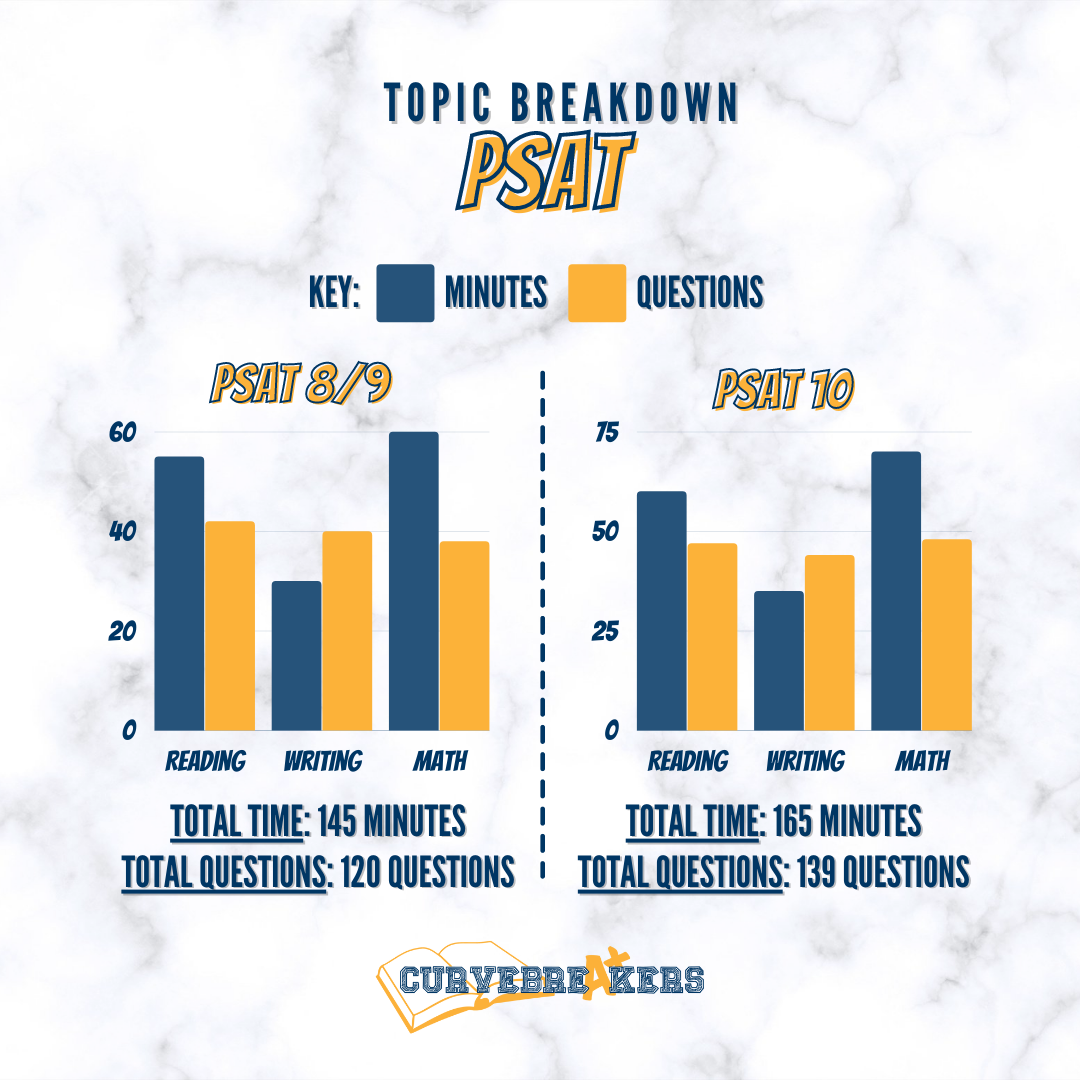In our previous blog about the PSAT, we talked about the benefits of the test and explained the difference between the three different types of tests. We also briefly mentioned the timing of each test, but this will be a more comprehensive breakdown of the PSAT that will look into the scoring, contents of the exam, best practices, and what is considered a good score.
What Subjects Are on the PSAT?
- The PSAT 8/9, the PSAT 10, and the PSAT/NMSQT cover the same subjects: evidence-based reading and writing, and math. The evidence-based reading and writing topic splits into a reading test and a language test. Unlike the SAT, there is no essay requirement.
- The PSAT 10 and the PSAT/NMSQT use the same scoring, different from the PSAT 8/9. To avoid repetitiveness and confusion, we will be referring to two tests: the PSAT 8/9 and the PSAT 10.
- As mentioned previously, the PSAT 8/9 is 2 hours and 25 minutes, while the PSAT 10 is 2 hours and 45 minutes.
Explaining the Scoring of the PSAT
- On the PSAT 8/9, the total score ranges from between 220 and 1440. Each of the sections can give a maximum score of 720. The College Board has a benchmark system to let students know what scores they need to earn. A 9th grader should be aiming for a 410 in reading and a 450 in math.
- The total score for the PSAT 10 ranges from between 320 and 1520, with the section scores ranging between 160 and 760. Sophomores should be aiming for a 430 on reading and a 480 on math. Juniors should be aiming for 30 points higher in each section.
- The benchmarks mentioned earlier make sure students are on track for College and Career readiness. The College Board grade reports are color-coded to either be red, yellow, or green. Green means students meet or exceed the benchmark, while yellow and red determine how far the student is from the said benchmark.
Test Length and Timing
| PSAT 8/9 | PSAT 10 | ||||
| Component | Minutes | Questions | Component | Minutes | Questions |
| Reading | 55 | 42 | Reading | 60 | 47 |
| Writing | 30 | 40 | Writing | 35 | 44 |
| Math | 60 | 38 | Math | 70 | 48 |
| Total | 145 | 120 | Total | 165 | 139 |
Breakdown of the Reading & Writing Sections of the PSAT
- All the questions on the reading test are multiple-choice based on the passages included. Some reading passages link together, and there may be questions based on graphs and charts, but there is no math. There are usually five passages in the reading section.
- The five passages always include a US founding document, a classic work of world literature, a selection about a social science such as psychology, and two science passages. When taking the test, one will not need prior knowledge outside of the information presented in the passage.
- The writing test is also all multiple-choice based on passages or graphs and charts. This test will ask students to choose an answer that corrects the grammar in a sentence or paragraph or the interpretation of a graph.
Breakdown of the Math Section of the PSAT
- The math section tests you on math problems you are most likely to encounter in college math courses and everyday life. Most of the math test questions are multiple-choice, but there are grid-in questions, which ask that students write down a two or three-digit answer.
- The math test divides into two portions: one that allows students to use a calculator and one that does not. The main focus is the three areas of math that hold the most significance in college and career.
- These areas are “Heart of Algebra,” which focuses on linear equations and systems; “Problem Solving and Data Analysis,” which requires students to be quantitatively literate; and “Passport to Advanced Math,” which requires students to manipulate complex equations.
- PSAT 10 takers will also have to complete “Additional Topics in Math,” featuring geometry, trigonometry, and more.
Why Does the PSAT Matter?
- Students may wonder if the goal of the PSAT is to correctly answer math and reading questions to set themselves up for college, but the test helps students apply these concepts well further into life.
- The math test asks that students understand how math concepts and operations work, such as (PEMDAS). The priority, however, is mathematical applications to real-world problems. Many trigonometry problems use engineering examples to challenge students to understand how these concepts apply to the real world.
- The main thing that the reading test in the PSAT and other reading practice tests teach is how to become a better writer. These tests ask that students re-read their work, find mistakes, and fix them.
- The PSAT exams allow for students to practice standardized testing without the threat of a bad grade. These exams also let them experiment to become better students and learners.
Want to learn the best strategies for the PSAT?
Check out our self-study “YouTube-style” PSAT Strategy Accelerator Course.


